
The Cispadane Republic was a short-lived client republic located in northern Italy, founded in 1796 with the protection of the French army, led by Napoleon Bonaparte. In the following year, it was merged with the Transpadane Republic to form the Cisalpine Republic. The Cispadane Republic was the first Italian sovereign State to adopt the Italian tricolour as flag.
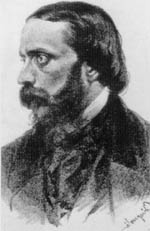
Giuseppe Rovani was an Italian novelist and essayist.

Teodulo Mabellini was an Italian composer.

Giorgio Jan was an Italian taxonomist, zoologist, botanist, herpetologist, and writer. He is also known as Georg Jan or Georges Jan.

Giuseppe Vermiglio was a Caravaggist painter from Northern Italy, active also in Rome.

Alfonso Michele Litta was an Italian nobleman who was a Cardinal and Archbishop of Milan from 1652 to 1679.
Antonia Malatesta of Cesena, also known as Antonia Malatesta of Rimini, was a Duchess of Milan by marriage to Giovanni Maria Visconti. She was the Regent of Milan in the interim after the death of her spouse in 1412.
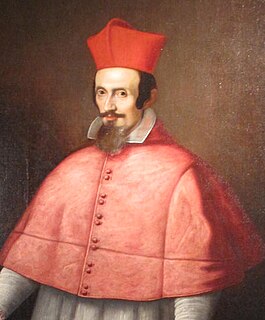
Cesare Monti was an Italian Cardinal who served as Latin Patriarch of Antioch and Archbishop of Milan.

Giuseppe Archinto was an Italian diplomat, Cardinal and Archbishop of Milan from 1699 to 1712.
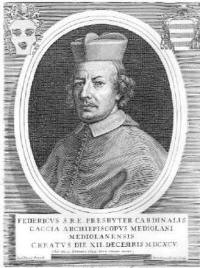
Federico Caccia was an Italian diplomat, Cardinal, and Archbishop of Milan from 1693 to 1699.
Luigi Ferdinando Casamorata was an Italian composer and music critic.

Bologna was a newspaper published in Bologna from 1642 to 1787. It is considered one of the oldest newspapers in Italy.

Il Corriere di Gabinetto - Gazzetta di Milano was a newspaper published in Milan from 1 July 1785 to 1797 by the Pirola brothers. It was known as Il Corriere di Gabinetto from 2 July 1794 to May 1796 and as Gazzetta di Milano from 21 May 1796 to his last number dated 28 December 1797.
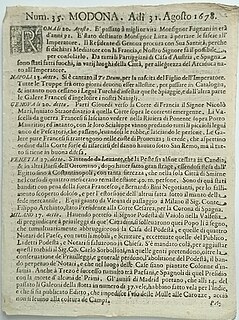
Modona was a newspaper published in Modena from 1677 to 1701 by Demetrio Degni.

Il Messaggiere, from 1800 Il Messaggere, was a newspaper published in Modena between 1749 and 1859, with some interruptions during the Napoleonic era. It was the official newspaper of the Duchy of Modena and Reggio.

Genova was a newspaper published in Genoa from 1639 to 1646. The issue dated 29 July 1639 is the oldest issue still in existence of a newspaper printed in Italy.
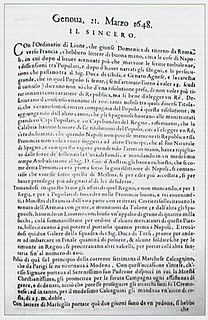
Genova was a newspaper published in Genoa from 1642 to 1684. This newspaper had sometime additional titles: in a few issues the addition was Il Sincero, other issues had the additional title Il Botticelli, while two issues had only as title the year in Latin digits.

The cockade of Italy is the national ornament of Italy, obtained by folding a green, white and red ribbon into a plissé using the technique called plissage (pleating). It is one of the national symbols of Italy and is composed of the three colours of the Italian flag with the green in the centre, the white immediately outside and the red on the edge. The cockade, a revolutionary symbol par excellence, was the protagonist of the uprisings that characterized the Italian unification, being pinned on the jacket or on the hats in its tricolour form by many of the patriots of this period of Italian history. During which, the Italian Peninsula achieved its own national unity, culminating on 17 March 1861 with the proclamation of the Kingdom of Italy. On 14 June 1848, it replaced the azure cockade on the uniforms of some departments of the Royal Sardinian Army, while on 1 January 1948, with the birth of the Italian Republic, it took its place as a national ornament.

Marco Giuseppe Compagnoni was an Italian constitutionalist, writer and journalist, considered the "father of the Italian flag", since he was the first to propose the official use of the flag of Italy for a sovereign Italian state, the Cispadane Republic, on 7 January 1797.



















